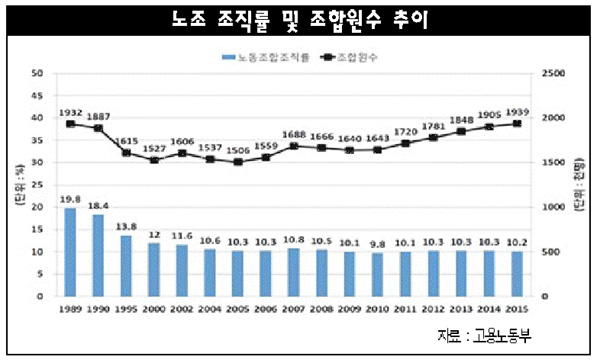
▲ The Trend of Unionization Rate and Trade Union Membership
Source: Ministry of Employment and Labor
The trade union membership in Korea has reached a record high of 1,939,000 members as of the end of 2015, breaking the previous record of 1,932,000 in 1989.
This is the highest union membership since the government commenced to survey the trade union situation in 1965, which is in fact the highest number of unionized workers recorded after the formation of the Republic of Korea in 1948. The membership expansion can be explained that along with the population increase, the wage workers have also climbed up the curve.
The union membership increase was also attributed to the enhanced labor rights for the school teachers and public employees who were allowed to form and join the trade unions during the previous Kim Dae-jung and Roh Moo-hyun governments. The Ministry of Employment and Labor(MOEL) on October 26 unveiled the 2015 trade union situation.
Last year the union membership was 1,938,745, increased by 33,275 members(up with 1.7%) compared with the union membership in 2014. When the government started to record the trade union membership in 1965, the union membership was 301,000 and it is estimated that before 1965 the union membership would have been much lower.
Since then the union membership steadily increased and in 1978 it exceeded 1 million membership(1,055,000) first time ever. Particularly, immediately after the nationwide workers' struggle in 1987, the union membership shot up to 1,707,000 in 1988 and 1,932,000 in 1989. The union membership in 1987 was 1,267,000.
However, the union membership has declined for almost 10 years until 1998 with the membership of 1,402,000. When the teachers' union was legalized in 1999, the downward trend got reversed. The legalization of public employees' union brought up the union membership increase from 1,559,000 in 2006 to 1,688,000 in 2007, up with 130,000 members.
Nevertheless, the unionization rate is not in line with the trend of union membership increase. The highest unionization rate recorded was 19.8% in 1989 that was the peak period for the organized labor movement. In 2014 the unionization rate was only 10.2%, almost halved from the peak rate. With the increase of population and wage workers, the number of workers who are eligible for the trade union activities and used as the denominator for the unionization rate has also increased twofold(1.95 times) from 9,752,000 in 1989 to 19,027,000 in 2015.
The unionization rate fell to 9.8% in 2010 and stagnated at rate of 10.3% from 2012 to 2014 and in 2015 it fell by 0.1 percentage point to 10.2%.
The Federation of Korean Trade Unions(FKTU) has the largest membership of 843,442(43.5%) and the Korean Confederation of Trade Unions(KCTU) has the membership of 636,249(32.8%). Independent union membership which is not affiliated to the umbrella trade union national centers of FKTU and KCTU is 445,603(23%).
The industrial union membership out of the total union membership is 1.099,020 which is 56.7%, up with 22,000 members compared with the year 2015. Both trade union national centers put efforts to organize the workers in the industrial union system. The percentage of industrial union membership of the KCTU reached 83.6%, whereas that of FKTU was 46.1%.
The KCTU issued a statement that while denouncing the current labor law system which only allows the industrial unions superficially, it called for the guarantee of the practical roles that industrial unions shall play through the abolition of legal provisions which actually prohibit the workers from joining the industrial unions.
reported by Kim Bong-seok
edited in English by Kim Sung-jin

